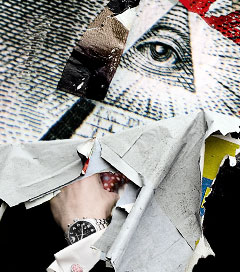Standard & Poor’s downgrade of America’s debt couldn’t come at a worse time. The result is likely to be higher borrowing costs for the government at all levels, and higher interest on your variable-rate mortgage, your auto loan, your credit card loans, and every other penny you borrow.
Why did S&P do it?
Not because America failed to pay its creditors on time. As you may have noticed, we avoided a default.
And not because we might fail to pay our bills at the end of 2012 if tea-party Republicans again hold the nation hostage when their votes will next be needed to raise the debt ceiling. This is a legitimate worry and might have been grounds for a downgrade, but it’s not S&P’s rationale.
S&P has downgraded the U.S. because it doesn’t think we’re on track to reduce the nation’s debt enough to satisfy S&P — and we’re not doing it in a way S&P prefers.
Here’s what S&P said: “The downgrade reflects our opinion that the fiscal consolidation plan that Congress and the administration recently agreed to falls short of what, in our view, would be necessary to stabilize the government’s medium-term debt dynamics.” S&P also blames what it considers to be weakened “effectiveness, stability, and predictability” of U.S. policy making and political institutions.
Pardon me for asking, but who gave Standard & Poor’s the authority to tell America how much debt it has to shed, and how?
If we pay our bills, we’re a good credit risk. If we don’t, or aren’t likely to, we’re a bad credit risk. When, how, and by how much we bring down the long term debt — or, more accurately, the ratio of debt to GDP — is none of S&P’s business.
S&P’s intrusion into American politics is also ironic because, as I pointed out recently, much of our current debt is directly or indirectly due to S&P’s failures (along with the failures of the two other major credit-rating agencies — Fitch and Moody’s) to do their jobs before the financial meltdown. Until the eve of the collapse S&P gave triple-A ratings to some of the Street’s riskiest packages of mortgage-backed securities and collateralized debt obligations.
Had S&P done its job and warned investors how much risk Wall Street was taking on, the housing and debt bubbles wouldn’t have become so large – and their bursts wouldn’t have brought down much of the economy. You and I and other taxpayers wouldn’t have had to bail out Wall Street; millions of Americans would now be working now instead of collecting unemployment insurance; the government wouldn’t have had to inject the economy with a massive stimulus to save millions of other jobs; and far more tax revenue would now be pouring into the Treasury from individuals and businesses doing better than they are now.
In other words, had Standard & Poor’s done its job over the last decade, today’s budget deficit would be far smaller and the nation’s future debt wouldn’t look so menacing.
We’d all be better off had S&P done the job it was supposed to do, then. We’ve paid a hefty price for its nonfeasance.
A pity S&P is not even doing its job now. We’ll be paying another hefty price for its malfeasance today.
We’re not backing down in the face of Trump’s threats.
As Donald Trump is inaugurated a second time, independent media organizations are faced with urgent mandates: Tell the truth more loudly than ever before. Do that work even as our standard modes of distribution (such as social media platforms) are being manipulated and curtailed by forces of fascist repression and ruthless capitalism. Do that work even as journalism and journalists face targeted attacks, including from the government itself. And do that work in community, never forgetting that we’re not shouting into a faceless void – we’re reaching out to real people amid a life-threatening political climate.
Our task is formidable, and it requires us to ground ourselves in our principles, remind ourselves of our utility, dig in and commit.
As a dizzying number of corporate news organizations – either through need or greed – rush to implement new ways to further monetize their content, and others acquiesce to Trump’s wishes, now is a time for movement media-makers to double down on community-first models.
At Truthout, we are reaffirming our commitments on this front: We won’t run ads or have a paywall because we believe that everyone should have access to information, and that access should exist without barriers and free of distractions from craven corporate interests. We recognize the implications for democracy when information-seekers click a link only to find the article trapped behind a paywall or buried on a page with dozens of invasive ads. The laws of capitalism dictate an unending increase in monetization, and much of the media simply follows those laws. Truthout and many of our peers are dedicating ourselves to following other paths – a commitment which feels vital in a moment when corporations are evermore overtly embedded in government.
Over 80 percent of Truthout‘s funding comes from small individual donations from our community of readers, and the remaining 20 percent comes from a handful of social justice-oriented foundations. Over a third of our total budget is supported by recurring monthly donors, many of whom give because they want to help us keep Truthout barrier-free for everyone.
You can help by giving today. Whether you can make a small monthly donation or a larger gift, Truthout only works with your support.
